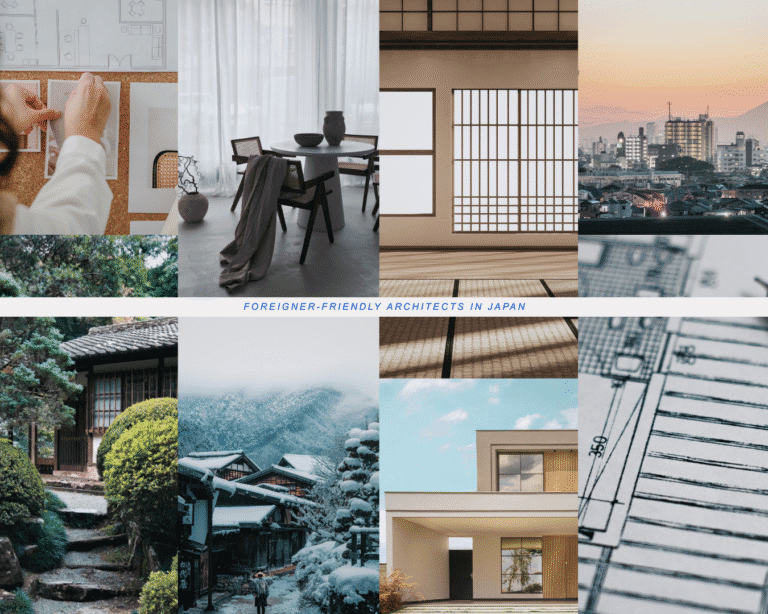Jump Ahead
The Global Renown of Japanese Gardens
The history of Japanese garden design can be traced as early as the Heian Era (794 to 1185), which led to a cultural breakthrough. To this day, they garner international admiration. This is due to their authentic tranquility and unwavering attention to detail.
Every element of Japanese garden design plays a distinct role in this.
The essence of these gardens owes much to their remarkable history. To design a Japanese garden that honors the centuries of cultural and historical significance – it is a great undertaking.
This challenge extends to those engaging in large-scale projects like creating a public garden, to reviving the gardens of traditional houses.
However, a crucial step to begin this intricate process is gathering knowledge. This article is comprehensive, yet is still a brief guide on the history of Japanese garden design; the ideals and values that underlie it, and the meaning behind some characteristic elements that have come to uniquely represent them.
The Beginnings of Japanese Garden Design
When did the history of Japanese garden design begin? To fully comprehend the significance of each design component, understanding where they came from is crucial.
Major contributions in Japanese garden design originated during the Heian Era (794 to 1185). Here, we turn to the Sakuteiki – “Records of Garden Making” – created during that period.
Professor emiritus, Jiro Takei, and landscape architect, Marc P. Keane’s Sakuteiki: Visions of the Japanese Garden provides expert analysis and research on this topic.
Dating back nearly a 1000 years ago, the Sakuteiki is one of the oldest records on Japanese garden design. The book is considered by many to be Japan’s very first landscape manual. It begins by introducing the “art of setting stones,” referring to the arrangement of stones.
This book became the earliest definition of Japanese garden landscaping [1].
It had three main functions:
- First, to serve as a technical journal for apprentices or builders, passing down teachings from their masters. [1]
- Second, it outlined the four main symbols within Japanese gardens: images of the natural world, ancient Chinese geomancy, Buddhism, and the systems present during the Heian Era. [1]
- Third, it highlighted the importance of stones in the foundation of these gardens. [1]
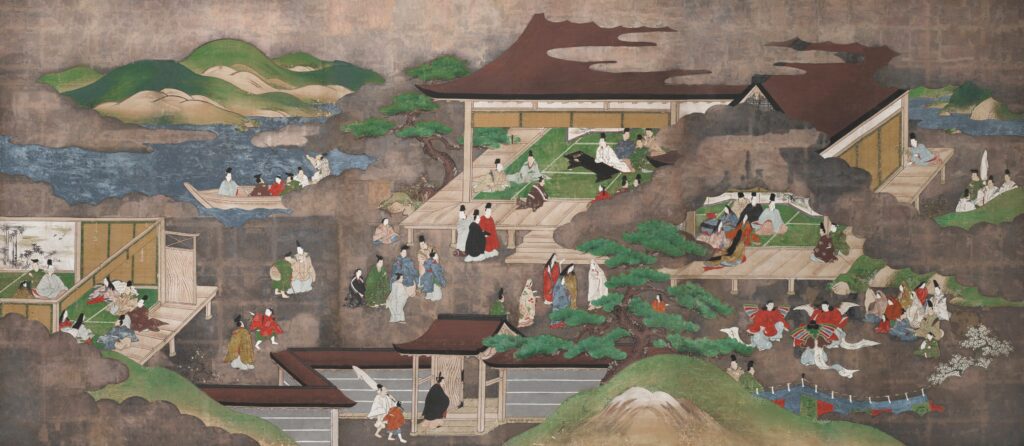
Depiction of a Heian Era estate with its gardens from Scenes from the Tale of Genji
SOURCE: Minneapolis Institute of Art. Digitally enhanced by rawpixel.
Evolution of Gardens – Innovations from Heian to Meiji Period
While the Heian era contributed extensively, there have been breakthroughs and transformations over centuries. The elements and categories of Japanese gardens gradually expanded.
Let’s explore the design innovations from each age through the following timeline:
Heian Era –> Kamakura Period –> Muromachi Period –>
Momoyama Period –> Edo/Tokugawa Period –> Meiji Period
1. Heian Era (794 – 1185)
Sleeping-Hall Gardens
The Heian Era saw a rise in shinden gardens. They are referred to as “sleeping-hall” gardens or shinden-zukuri (寝殿造り “sleeping-hall architecture”); a style of architecture favored by Heian nobles. [2]
During this time, many gardens were commissioned to be built for estates or palaces.
Hence, gardens of this era were associated with lavishness and grandeur. They are intricate and comprised of extravagant halls and annexes, large courtyard gardens, and grand ponds.
This style descended from Chinese gardens of the Zhou dynasty during the Nara Period but were more reserved than their counterpart. [2]

Layout of A Typical Heian Residence
SOURCE: [1]
Strolling Pond Gardens
The larger shinden garden could also include a Strolling Pond Garden or chisen kaiyushiki teien. [5] It was meant to be viewed from shore-side platforms and pavilions. [2] In modern-day public Japanese gardens, pavilions and platforms remain prominent elements.

Photo of Pond-garden in Heian-Jingū (Kyoto)
CREDIT: Tomoko Kamishima
There are no surviving estates or gardens directly from the Heian Era. However, there are replicas. The spacious pond-garden of the Heian-Jingū, for one, closely resembles Heian-period gardens. Another example is the garden at Nanzen-in Temple. [5]

Medieval or Heian-style Pond at Nanzen-in Temple within Nanzen-ji (Kyoto)
SOURCE: Ueyakato, JP
2. Kamakura Period (1185 – 1333)
Dry Landscape Gardens
The Kamakura and Muromachi eras combined (1185 – 1573 CE) popularized dry landscape gardens known as karesansui (枯山水). [17] While the first term is more accurate, they are also called Zen gardens. These were gardens consisting mainly of rock and raked gravel or sand.
While it has existed since the Heian Era, it was not until the late Kamakura period that karesansui became increasingly developed as a design. [16]
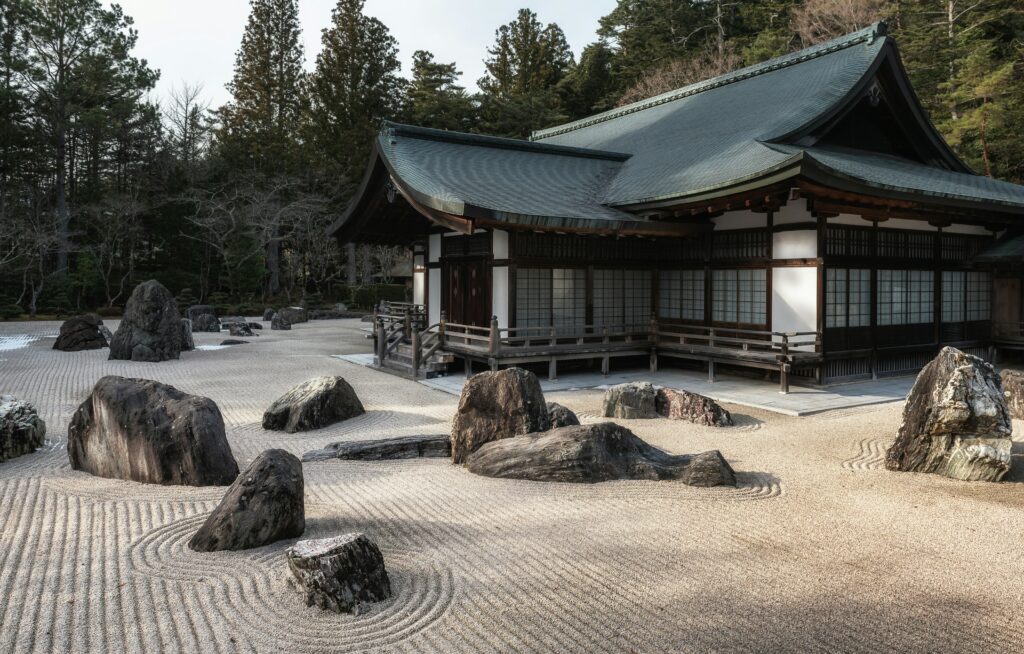
Dry garden at Koyasan Buddhist Temple, Wakayama Prefecture
CREDIT: Hu Chen
3. Muromachi Period (1338 – 1568)
Dry Landscape Gardens Develop
During the Muromachi Period, karensansui (枯山水) dry landscape gardens shifted from a subordinate to an independent garden design. [16] Previously, it had been only a small part of larger gardens.
These gardens encapsulated the tranquility and simplicity of Japanese gardens. It was meant to encourage contemplation and reflection. Portland Japanese Garden explains that yohaku-no-bi, meaning “the beauty of blank space,” is a vital Japanese aesthetic principle underlying this garden style. [17]

Dry Landscape Garden at the Ryōanji, Kyoto
CREDIT: David Emrich
The development of these gardens has strong ties to Zen Buddhism. Hence, karesansui was often seen in temples. However, it was also created within the grounds of palaces or wealthy estates. [6]
4. Momoyama Period (1568 – 1600)
Tea Gardens
This period produced one of the most iconic garden forms of all time: the tea gardens, or chaniwa (茶庭). They typically comprise of a pathway arranged by stepping stones, lanterns, and a tea house (chashitsu, 茶室), where tea ceremonies (chanoyu) are held. [19] The development of the chaniwa began in the late Muromachi period, but grew prominent in the Momoyama Period.

Jo-an Teahouse at Urakuen Garden (Inuyama City, Aichi Prefecture)
CREDIT: Aichi Now Official Tourism Site for Aichi
5. Edo (or Tokugawa) Period (1603 – 1868)
Stroll Garden
Stroll Gardens, called kaiyushiki teien (廻遊式庭園), or “excursion-style garden,” emerged during this period. [15] It combined many traditional elements from earlier styles – ponds, streams, waterfalls, islands, lanterns, stepping stones, bridges, teahouses and other structures. Hence, it might include a karesansui (dry landscape garden), a chaniwa (tea garden), or a pond garden.
Historically, strolling gardens were attached to the estates of aristocrats and feudal lords (daimyo). In Edo times — when this garden style flourished — its large scale and grandeur was a display of wealth and luxury for the daimyo. [12] Hence, stroll gardens were also called daimyo teien (大名庭園) or “feudal lord gardens.” [12]
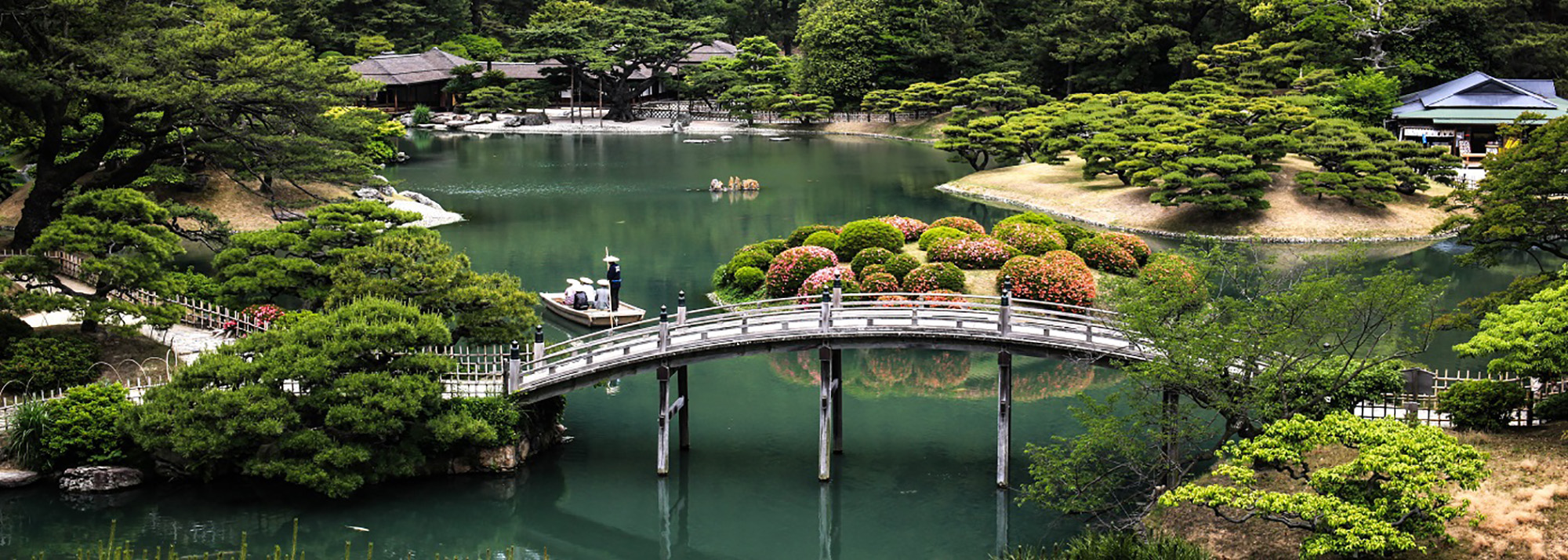
Engetsukyo Bridge at Ritsurin Garden, a famous stroll garden in Takamatsu City (Kagawa Prefecture)
CREDIT: Kagawa Official Tourism Website
Another important phenomenon: the popularization of tsuboniwa (坪庭) or “enclosed gardens.” These referred to small garden spaces, existing within houses or between buildings. Their size can vary from 1.8 to 3.3 meters squared. [18] Although they have existed since the Heian Era, it was during the Edo Period that tsuboniwa became popular among the masses. Its size made it convenient for many to include it in their own homes.

Tsuboniwa at Asakura Chōso Museum, Tokyo
CREDIT: The North American Japanese Garden Association (NAJGA)
6. Meiji Period (1867 – 1912)
Shifting Influences
From the Meiji Period onwards, Japanese gardens began to incorporate Western influences. Moreover, with the Meiji government reinstating Shintoism over Buddhism, there was a decline in the influence of Buddhist iconography in garden design. [8] Kyoto gardens created during this period demonstrate a new vision of “natural” landscape that were non-symbolic and more aesthetic. [9]
With the rising demand for modern living, Meiji Period garden design appealed to modern trends in its own way. It still borrowed from the Edo period and its showy style, but introduced a revolutionary vision for Japanese garden design. [9] This gave way to these gardens’ contemporary fashions. The spirit of modernity also permeates the garden of Murin-an. [9]
Murin-an(無鄰菴)Garden, Kyoto
CREDIT: Real Japanese Gardens
Philosophy and Buddhist Influences
The influence of Buddhism on the Japanese garden design history is long-standing. During the Heian Era, ishitateso – Buddhist priests involved in garden building [1] – infused the principles of Buddhism into the garden design.
Around this time, in the 12th century, Zen Buddhism also made its first appearance in Japan. [10] This strengthened the foundations of Buddhism especially in the Zen gardens of Kamakura and Muromachi eras.
It also explains the characteristic austerity and simplicity behind such gardens. For Zen is a Japanese translation of Chan, which is a sinification of dhyāna, a Sanskrit word meaning “meditation.” [10] The transmission of Zen wisdom is through contemplation – the spiritual and the nonverbal.
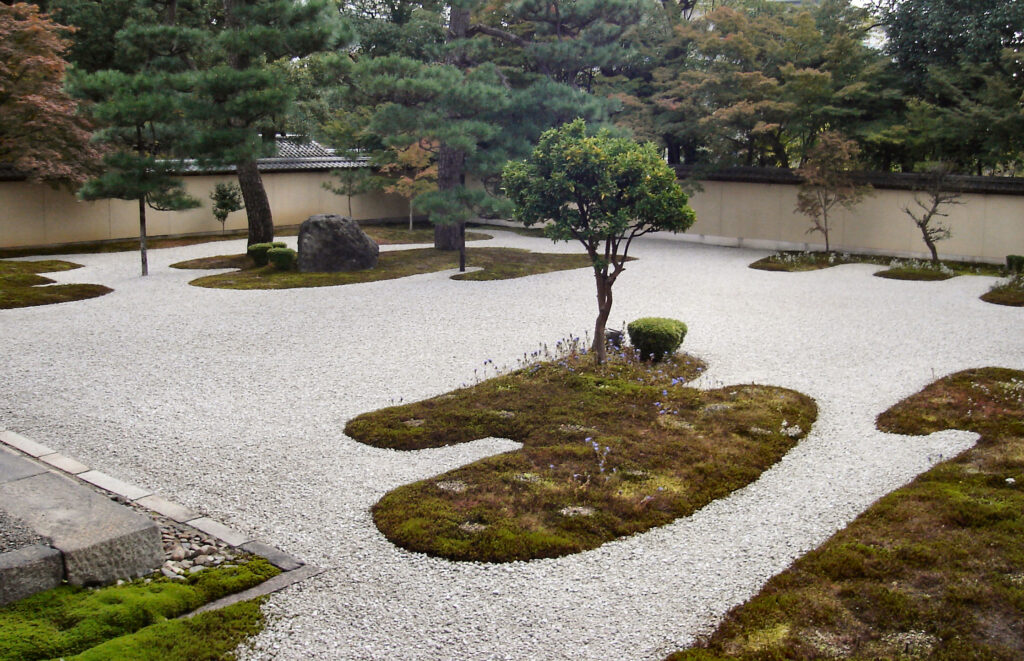
Genji Garden at Rozanji Temple, Kyoto
SOURCE: Photo byPlusMinus, Wikimedia Commons
However, in the Tokugawa Dynasty (1603–1867), Zen monasteries fell into decline, and their gardens became overlooked. [10] With the reinstatement of Shitoism in the Meiji Restoration of 1868, the influence of Buddhism in gardens continued to weaken.
Hence, Buddhist iconography and design principles became viewed in aesthetic rather than religiously relevant terms. [8] Only in the last seventy or so years have Zen gardens become iconic representations of Japanese culture once more. [10]
Significance of Stones in a Garden
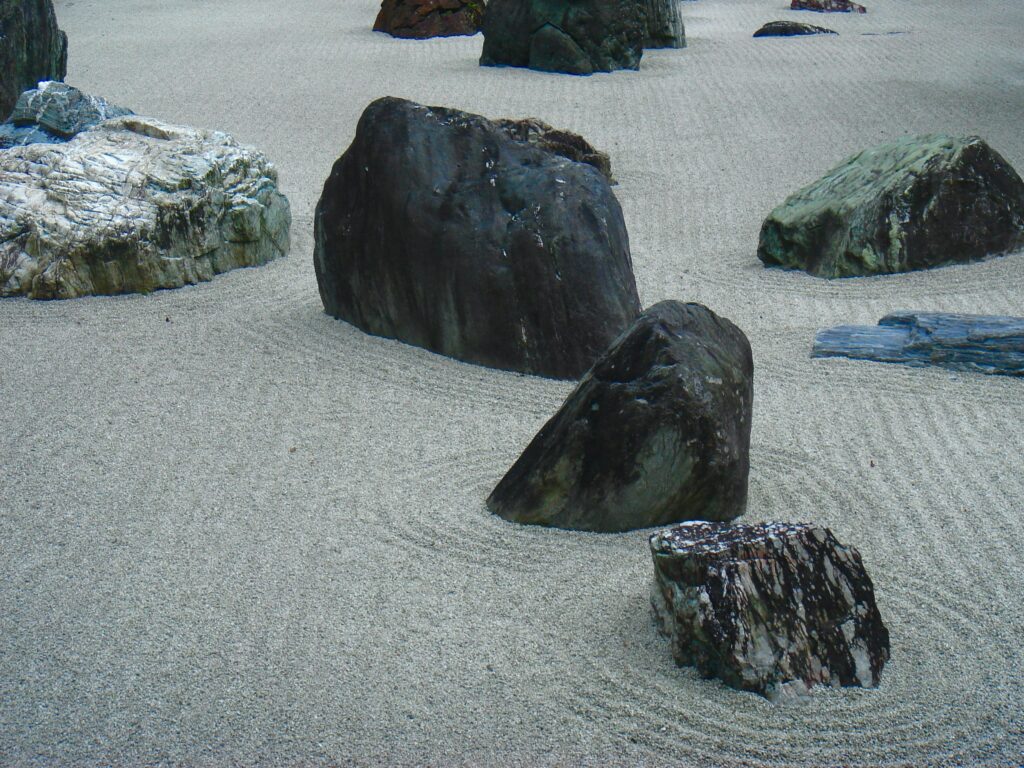
Koyasan Buddhist Temple Garden, Wakayama prefecture
CREDIT: Jonas Gerlach
Japanese gardens are composed of as many as ten or more elements – essential and decorative. [7] Central among them are water, trees, rocks, and sand. Rocks or stones, however, form the backbone of Japanese gardens. [4] Therefore, this article and this section specifically prioritize the importance of this feature.
Earlier, the Sakuteiki establishes stone setting as the equivalent of creating a garden. It can be used to represent mountains and natural landscapes within the miniaturized world of the garden. Stones are one of the earliest elements of Japanese garden design to emerge, which makes it foundational.
The spiritual significance that stones possess also make them a fundamental element. Stones have been associated with religious rituals long before the Sakuteiki. Iwakura – stones that carried a sacred meaning, served as prayer sites in ancient Japan. It remains a practice honored even in modern times. [1]
What Makes An Authentic Japanese Garden?
One must heed more caution in identifying or labeling a garden as “Japanese.”
The North American Japanese Garden Association (NAJGA) highlights a crucial point: A garden that is only Japanese in appearance is said to be wafū (和風 “wa [Japanese] wind”; Nihon-fū 日本風 “Japan wind”), or Japanese style.
Whereas a garden that is thoroughly Japanese in principle, spirit, and technique has washin (和心 “wa [Japanese] heart or spirit”).
In other words, replicating the style of Japanese garden without proper knowledge might sacrifice the authenticity.

View of Pavilion at Ritsurin Garden, Kagawa Prefecture
CREDIT: H C, Unsplash
“The garden has come to constitute a necessity in life, not so much for the physical as for the mental and spiritual.” — Jiro Harada [9]
Sources
[1] Takei J. and Keane M. “Sakuteiki: Visions of the Japanese Garden: A Modern Translation of Japan’s Gardening Classic.” Tuttle Publishing, 2008.
[2] Deane, Andrew R. “Chapter 3: The Heian Estate Garden.” North American Japanese Garden Association, 2015.
[3] “Strolling Pond Garden.” Portland Japanese Garden
[4] Kato, T. and Ogura N. “In the Japanese rock garden.” Architectural Review, 2022.
[5] “The Strolling Pond Garden.” Ueyakato, JP
[6] Webb, Mia. “Japanese Zen Gardens During the Muromachi Period.” Connecticut College, Asian Art and Architecture
[7] Bowdoin College, Japanese Gardens
[8] Schöppler, Luke. “The Meiji Legacy: Gardens and Parks of Japan and Britain, 1850-1914.” University of Derby, 2020.
[9] Watanabe, Toshio. “A Kyoto Garden Renewal? From Meiji to Early Showa Period”
[10] Cunnigham, Eric. “Cultivating Enlightenment: The Manifold Meaning of Japanese Zen Gardens.” Association for Asian Studies
[11] Bryant, Anthony J. “Shinden-Zukuri Estates of the Heian Period.” Sengoku Daimyo
[12] “The Culture of Gardens.” Tokyo Metropolitan Park Association
[13] Young, David and Yound, Michiko. Art of the Japanese Garden: History / Culture / Design. 2005
[14] Japanese Garden Dictionary. Compiled and edited by Ono Kenkichi and Walter Edwards.
[15] Kennedy, Corinne. “The Seattle Japanese Garden: Designed in the Stroll Garden Style.” Seattle Japanese Garden
[16] Deane, Andrew R. “Chapter 5: The Dry Landscape Garden.” North American Japanese Garden Association, 2015.
[17] “Sand and Stone Garden.” Portland Japanese Garden
[18] Deane, Andrew R. “Chapter 8: The Courtyard Garden.” North American Japanese Garden Association, 2015.
[19] “Tea Garden.” Portland Japanese Garden


